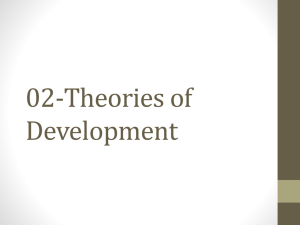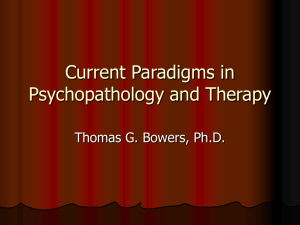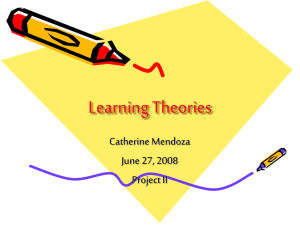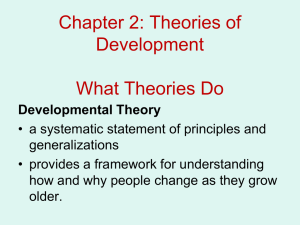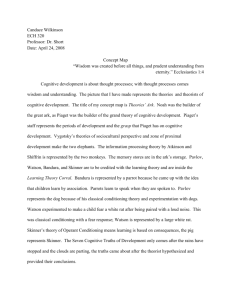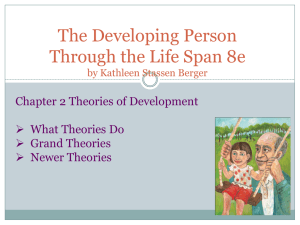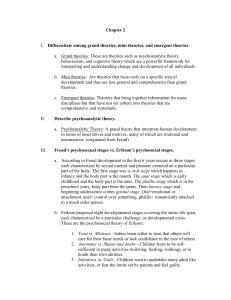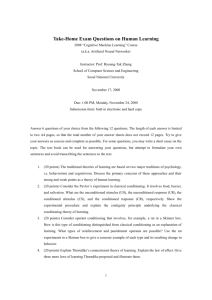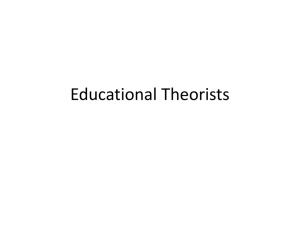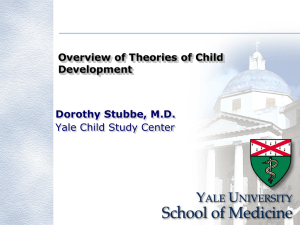Psychoanalytic theory
advertisement
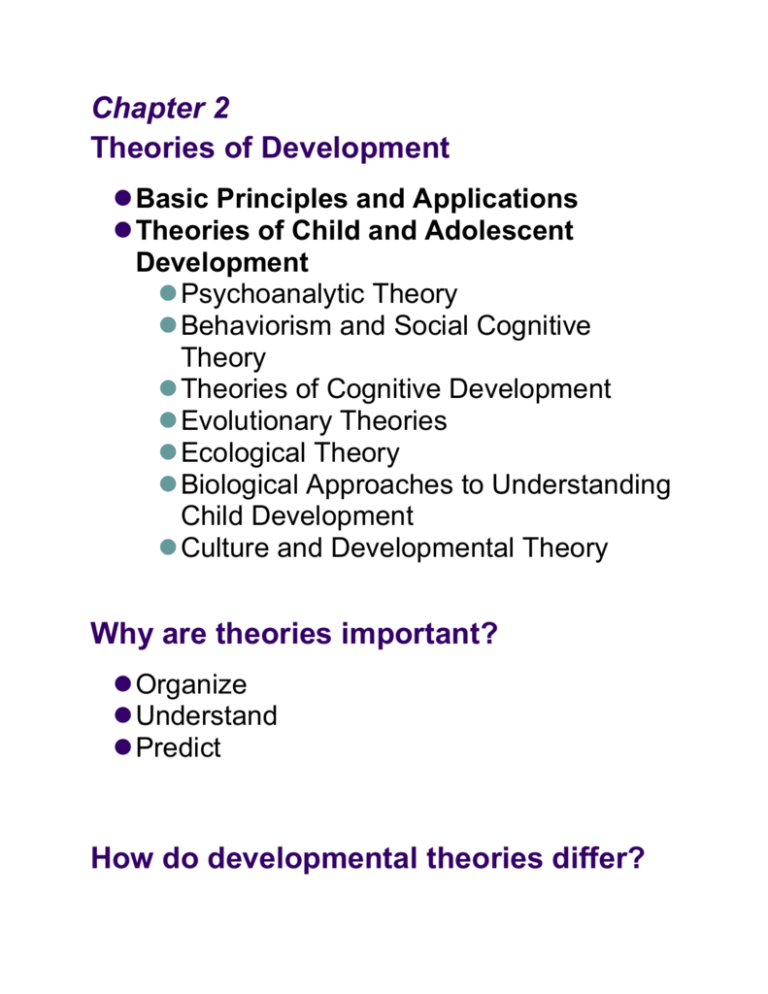
Chapter 2 Theories of Development Basic Principles and Applications Theories of Child and Adolescent Development Psychoanalytic Theory Behaviorism and Social Cognitive Theory Theories of Cognitive Development Evolutionary Theories Ecological Theory Biological Approaches to Understanding Child Development Culture and Developmental Theory Why are theories important? Organize Understand Predict How do developmental theories differ? How does development happen? Quantitative versus qualitative change Why does development happen? Biological forces Environmental factors Psychoanalytic theory: Sigmund Freud 3 parts of the personality: Id – pleasure principle Ego – reality principle Superego – conscience, morality Psychosexual stages of development Oral – 0-2 years focus of pleasure is on the mouth, taking in Anal – 2-3 years focus of pleasure is on the anus, potty training Phallic – 3-6 years focus of pleasure is on the penis for boys, clitoris for girls, Oedipus and Electra crisis Latency – 6-12 years olds sexual drive goes underground and gives energy to learning to be an adult, schooling Genital – 12 and older adult sexuality Psychoanalytic theory: Erik Erikson Psychosocial stages of development trust vs. mistrust autonomy vs. shame and doubt Eight stages from birth to old age A comparison of Freud’s and Erikson’s stages Freud Oral stage Anal stage Phallic stage Latency stage Genital stage Erikson Trust vs. mistrust Autonomy vs. shame/doubt Initiative vs. guilt Industry vs. inferiority Identity vs. role confusion Intimacy vs. isolation Generativity vs. stagnation Integrity vs. despair Behaviorism John B. Watson and classical conditioning We are born a “tabula rasa” (blank slate). Our environment determines our behavior. Classical conditioning Classical conditioning: pairing of stimuli Pavlov’s dogs http://www.edpsycinteractive.org/topics/behs ys/classcnd.html John Watson and Little Albert http://www.youtube.com/watch?v=KxKfpKQzow 8 B.F. Skinner and operant conditioning Operant conditioning: a voluntary response is strengthened by its association with positive consequences. Reinforcement: a stimulus that increases the likelihood that a behavior will be repeated. Negative reinforcement: removal of a stimulus increases the likelihood that a behavior will be repeated. Punishment: a negative consequence reduces the likelihood of a behavior happening again. Extinction: ignoring a behavior makes it stop Skinner’s pigeons and schedules of reinforcement: http://www.youtube.com/watch?v=I_ctJqjlrHA Albert Bandura and Social-Cognitive theory Learning through imitation (modeling) Differs from behaviorism in looking at inner mental processes Bandura’s classic experiment http://video.google.com/videoplay?docid=4586465813762682933&q=bandura+experi ment&total=5&start=0&num=10&so=0&type= search&plindex=1 Piaget’s theory of cognitive development How does development occur? Schemes how we organize the world in our minds Assimilation changing the world to fit what we already know Accommodation changing our schemes to fit the world Piaget’s stages of cognitive development Sensorimotor Birth–2 years Infants take in information through their senses and their action upon the world. Preoperational 2–7 years Young children do not yet think logically, and their thinking is egocentric Concrete operations 7–12 years Children now think logically, but their thinking is concrete and not abstract. Formal operations 12 years and older Adolescents can think both logically and abstractly. Vygotsky’s sociocultural theory All learning is social. Zone of proximal development (ZPD): the distance between the child’s independent abilities and what the child can do with a little help Scaffolding: adults help the “construction” of the child’s understanding by providing guidance and support at the ZPD. Information processing Cognitive theory that likens the mind to a computer Two models of information processing Stores model Sensory memory Short-term or working memory Long-term memory Connectionist or network model a neural network that consists of concept nodes that are interconnected by links Evolutionary perspective Darwin’s theory of evolution: adaptation to the environment in order to pass on genes Ethology Konrad Lorenz: Imprinting http://video.google.com/videosearch?so urceid=navclient&ie=UTF8&rlz=1T4ADB R_enUS246US262&q=konrad%20loren z&um=1&sa=N&tab=wv# Bonding vs. attachment Sociobiology: Edward O. Wilson The role of genes in social behavior and culture Bronfenbrenner’s Ecological theory Individuals grow and develop within a nested set of influences: Microsystem Mesosystem Exosystem Macrosystem Chronosystem Biological approaches Maturational theory: Arnold Gesell Dynamic systems theory: Esther Thelen Neuropsychology Behavioral genomics

